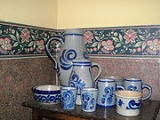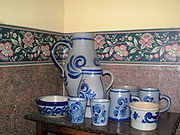
Westerwald Pottery
Encyclopedia

Stoneware
Stoneware is a vitreous or semi-vitreous ceramic ware with a fine texture. Stoneware is made from clay that is then fired in a kiln, whether by an artisan to make homeware, or in an industrial kiln for mass-produced or specialty products...
is a distinctive type of salt glazed grey pottery
Pottery
Pottery is the material from which the potteryware is made, of which major types include earthenware, stoneware and porcelain. The place where such wares are made is also called a pottery . Pottery also refers to the art or craft of the potter or the manufacture of pottery...
from the Höhr-Grenzhausen
Höhr-Grenzhausen
Höhr-Grenzhausen is a town in the Westerwaldkreis in Rhineland-Palatinate, Germany. It is a centre for the ceramic industry in the Kannenbäckerland with a professional college for ceramics, another for ceramic form, and many others, hence the nickname Kannenbäckerstadt .Together with the...
and Ransbach-Baumbach
Ransbach-Baumbach
Ransbach-Baumbach is a town in the Westerwaldkreis in Rhineland-Palatinate, Germany. Ransbach-Baumbach is the seat of the Verbandsgemeinde of Ransbach-Baumbach, a kind of collective municipality.-Location:...
area of Westerwaldkreis
Westerwaldkreis
The Westerwaldkreis is a district in the east of Rhineland-Palatinate, Germany...
in Rheinland-Pfalz, Germany
Germany
Germany , officially the Federal Republic of Germany , is a federal parliamentary republic in Europe. The country consists of 16 states while the capital and largest city is Berlin. Germany covers an area of 357,021 km2 and has a largely temperate seasonal climate...
.
It is known as Kannenbäckerland Stoneware. Typically it is decorated with cobalt
Cobalt
Cobalt is a chemical element with symbol Co and atomic number 27. It is found naturally only in chemically combined form. The free element, produced by reductive smelting, is a hard, lustrous, silver-gray metal....
blue painted designs, though the collectable items are more multicoloured.
There is a Keramik museum at Höhr-Grenzhausen that displays the construction techniques and the history of salt glaze.

